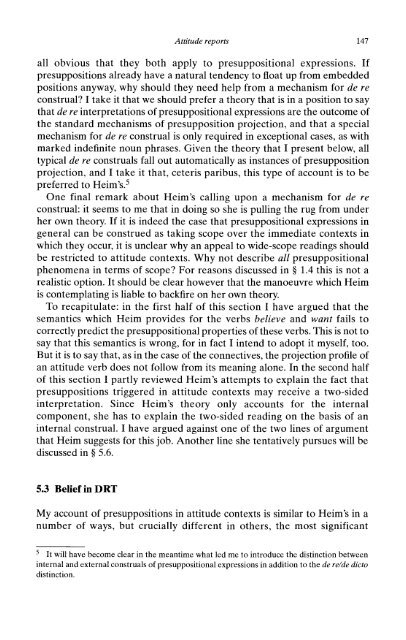Presuppositions and Pronouns - Nijmegen Centre for Semantics
Presuppositions and Pronouns - Nijmegen Centre for Semantics
Presuppositions and Pronouns - Nijmegen Centre for Semantics
You also want an ePaper? Increase the reach of your titles
YUMPU automatically turns print PDFs into web optimized ePapers that Google loves.
Attitude reports 147<br />
all obvious that they both apply to presuppositional expressions. If<br />
presuppositions already have a natural tendency to float up from embedded<br />
positions anyway, why should they need help from a mechanism <strong>for</strong> de re<br />
construal I take it that we should prefer a theory that is in a position to say<br />
that de re interpretations of presuppositional expressions are the outcome of<br />
the st<strong>and</strong>ard mechanisms of presupposition projection, <strong>and</strong> that a special<br />
mechanism <strong>for</strong> de re construal is only required in exceptional cases, as with<br />
marked indefinite noun phrases. Given the theory that I present below, all<br />
typical de re construals fall out automatically as instances of presupposition<br />
projection, <strong>and</strong> I take it that, ceteris paribus, this type of account is to be<br />
preferred to Heim's. 'so 5<br />
One final remark about Heim's calling upon a mechanism <strong>for</strong> de re<br />
construal: it seems to me that in doing so she is pulling the rug from under<br />
her own theory. If it is indeed the case that presuppositional expressions in<br />
general can be construed as taking scope over the immediate contexts in<br />
which they occur, it is unclear why an appeal to wide-scope readings should<br />
be restricted to attitude contexts. Why not describe all presuppositional<br />
phenomena in terms of scope For reasons discussed in § 1.4 this is not a<br />
realistic option. It should be clear however that the manoeuvre which Heim<br />
is contemplating is liable to backfire on her own theory.<br />
To recapitulate: in the first half of this section I have argued that the<br />
semantics which Heim provides <strong>for</strong> the verbs believe <strong>and</strong> want fails to<br />
correctly predict the presuppositional properties of these verbs. This is not to<br />
say that this semantics is wrong, <strong>for</strong> in fact I intend to adopt it myself, too.<br />
But it is to say that, as in the case of the connectives, the projection profile of<br />
an attitude verb does not follow from its meaning alone. In the second half<br />
of this section I partly reviewed Heim's attempts to explain the fact that<br />
presuppositions triggered in attitude contexts may receive a two-sided<br />
interpretation. Since Heim's theory only accounts <strong>for</strong> the internal<br />
component, she has to explain the two-sided reading on the basis of an<br />
internal construal. I have argued against one of the two lines of argument<br />
that Heim suggests <strong>for</strong> this job. Another line she tentatively pursues will be<br />
discussed in § 5.6.<br />
5.3 Belief in D DRT<br />
My account of presuppositions in attitude contexts is similar to Heim's in a<br />
number of ways, but crucially different in others, the most significant<br />
5<br />
5 It will have become clear in the meantime what led me to introduce the distinction between<br />
internal <strong>and</strong> external construals of presuppositional expressions in addition to the de re/de dicto<br />
distinction.














